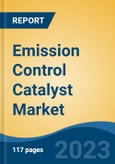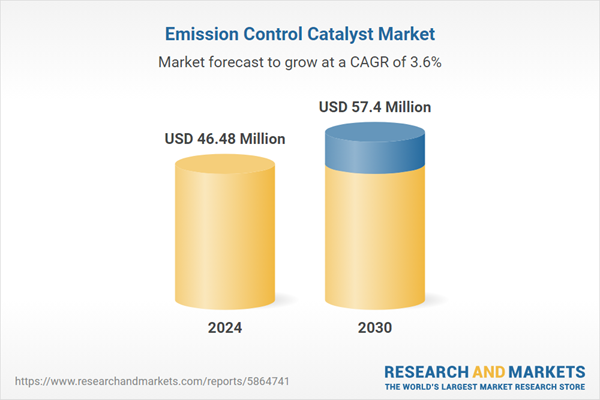Speak directly to the analyst to clarify any post sales queries you may have.
10% Free customizationThis report comes with 10% free customization, enabling you to add data that meets your specific business needs.
While the market faces challenges including volatility in precious metal prices and complex regulatory compliance across regions, its growth trajectory remains strong. Continued investment in advanced catalyst research, enhanced recycling technologies for precious metals, and a strategic shift toward cleaner fuel alternatives are anticipated to drive sustained market development. Collectively, these factors underscore the emission control catalyst market’s vital role in advancing global environmental objectives and improving air quality standards.
Key Market Drivers
Rapid Growth of the Automotive Sector
The rapid growth of the automotive sector is a primary catalyst driving the expansion of the global emission control catalyst market. As In 2023, global vehicle production totaled 93.5 million units, reflecting continued strength in automotive manufacturing despite ongoing industry challenges and sales escalate worldwide particularly in emerging economies such as China, India, and Southeast Asia the demand for advanced emission control technologies intensifies accordingly.The automotive industry faces mounting pressure to comply with increasingly stringent emission regulations aimed at reducing harmful pollutants like nitrogen oxides (NOx), carbon monoxide (CO), hydrocarbons (HC), and particulate matter (PM). These regulations, exemplified by standards such as Euro 6/7, China VI, and Bharat Stage VI, compel automakers to integrate sophisticated catalytic converters equipped with high-performance emission control catalysts. Consequently, the surge in new vehicle registrations directly translates into heightened demand for these catalysts.
The diversification of powertrains including traditional gasoline and diesel engines, as well as hybrid systems expands the scope of catalyst application. While electric vehicles reduce tailpipe emissions, hybrid vehicles still rely on internal combustion engines, necessitating effective emission control solutions. The increasing complexity and miniaturization of automotive electronics and exhaust systems also drive innovation in catalyst materials and design to optimize performance within confined spaces. Growing consumer awareness of environmental issues and government incentives for cleaner transportation accelerate the adoption of low-emission vehicles, further bolstering catalyst demand. The commercial vehicle segment, encompassing trucks and buses, is another significant contributor, as these vehicles typically operate under rigorous conditions requiring durable and efficient emission control systems.
The rapid expansion and technological evolution of the automotive sector are central to the growth of the global emission control catalyst market. The need to meet regulatory compliance, coupled with rising vehicle volumes and diverse powertrain technologies, ensures sustained and robust demand for advanced emission control catalysts.
Key Market Challenges
Volatility and High Cost of Precious Metals
Emission control catalysts heavily rely on precious metals such as platinum, palladium, and rhodium, which constitute a substantial portion of the overall catalyst cost. Price volatility and supply constraints of these metals can lead to increased production expenses and supply chain uncertainties. These factors may limit manufacturers’ ability to produce cost-competitive catalysts, particularly impacting price-sensitive markets and delaying adoption in emerging regions.Key Market Trends
Integration of Advanced Sensor and Monitoring Technologies
The adoption of real-time emission monitoring and smart sensor technologies within vehicles and industrial equipment is enhancing catalyst performance management. These systems enable precise control of catalytic reactions, adaptive adjustments to changing conditions, and predictive maintenance. By improving the efficiency and longevity of emission control catalysts, sensor integration supports regulatory compliance and reduces operational costs. This convergence of emission control with digital technologies opens avenues for innovation and value-added services in the market.Key Market Players
- Johnson Matthey
- Solvay
- Umicore
- Corning Incorporated
- Aerinox
- Cormetech
- BASF SE
- DCL International Inc.
- Shell Global
- CLARIANT
Report Scope:
In this report, the Global Emission Control Catalyst Market has been segmented into the following categories, in addition to the industry trends which have also been detailed below:Emission Control Catalyst Market, By Product:
- Palladium
- Platinum
- Rhodium
- Others
Emission Control Catalyst Market, By Application:
- Automotive
- Industrial
- Others
Emission Control Catalyst Market, By End Use:
- Automotive & Transportation
- Chemical Industry
- Oil & Gas Industry
- Mining Industry
- Power Industry
- Others
Emission Control Catalyst Market, By Region:
- North America
- United States
- Canada
- Mexico
- Europe
- France
- United Kingdom
- Italy
- Germany
- Spain
- Asia-Pacific
- China
- India
- Japan
- Australia
- South Korea
- South America
- Brazil
- Argentina
- Colombia
- Middle East & Africa
- South Africa
- Saudi Arabia
- UAE
Competitive Landscape
Company Profiles: Detailed analysis of the major companies present in the Global Emission Control Catalyst Market.Available Customizations:
With the given market data, the publisher offers customizations according to a company's specific needs. The following customization options are available for the report.Company Information
- Detailed analysis and profiling of additional market players (up to five).
This product will be delivered within 1-3 business days.
Table of Contents
Companies Mentioned
The leading companies profiled in this Emission Control Catalyst market report include:- Johnson Matthey
- Solvay
- Umicore
- Corning Incorporated
- Aerinox
- Cormetech
- BASF SE
- DCL International Inc.
- Shell Global
- CLARIANT
Table Information
| Report Attribute | Details |
|---|---|
| No. of Pages | 180 |
| Published | September 2025 |
| Forecast Period | 2024 - 2030 |
| Estimated Market Value ( USD | $ 46.48 Million |
| Forecasted Market Value ( USD | $ 57.4 Million |
| Compound Annual Growth Rate | 3.5% |
| Regions Covered | Global |
| No. of Companies Mentioned | 11 |









